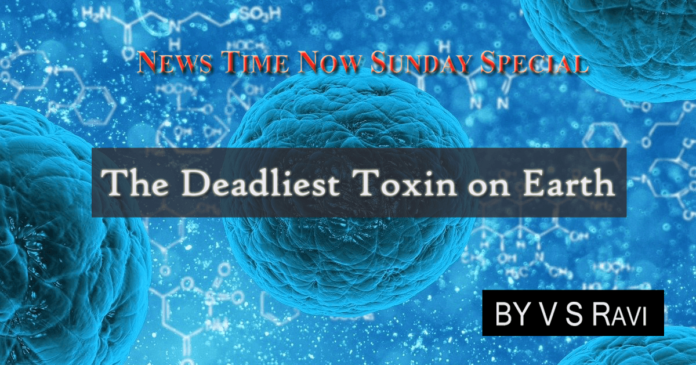All medical practitioners, as well as laymen, are aware that food poisoning can result in serious and disastrous consequences, involving the digestive system. However, there is one form of foodborne poisoning, known as botulism, caused by toxins from bacteria called Clostridium botulinum (there are actually three forms) which the latter would not most probably be aware of.
The harmful bacteria causing food borne botulism thrive and produce the toxin in environments without oxygen,
The source of foodborne botulism is often home-canned foods, that are low in acid, such as fruits, vegetables hand fish. However, the disease has also occurred from spicy peppers (chiles), foil-wrapped baked potatoes, and oil infused with garlic.
When you eat food containing the toxin, it disrupts nerve function, causing paralysis.
Wound botulism is caused by bacteria which get into a cut, and cause a dangerous infection that produces the toxin. When C. botulinum bacteria get into a wound — possibly caused by an injury you might not notice — they can multiply and produce toxin. Wound botulism has increased in recent decades in people who inject heroin, which contain spores of the bacteria. In fact, this type of botulism is more common in people who inject black tar heroin.
Infant botulism, which is the most common form of botulism, begins after Clostridium botulinum bacterial spores grow in a baby’s intestinal tract. It typically occurs in babies between the ages of 2 months and 8 months. Babies get infant botulism after consuming spores of the bacteria, which then grow and multiply in their intestinal tracts and make toxins. The source of infant botulism may be honey, but also certain other infant foods contaminated with the bacteria
All types of botulism can be fatal and are considered medical emergencies.
It is now recognised that among the few most deadly poisons known to medical science, botulism is the deadliest, and ranks even far above rabies and tetanus in the rapidity with which it strikes down the victim or in its mortality rate.
Clostridium botulinum, the organism causing botulism, is not a common cause of human disease as are the bacilli causing typhoid or cholera or the hordes of various bacteria that ravage us from time to time.However, Clostridium botulinum is feared for its consummate skill in manufacturing the most potent toxin known to man. Ten millionths of a microgram can kill a human being.
About ten years ago, a tiny bacillus growing in canned salmon produced a rare tragedy due to botulism, in Great Britain. The immediate result was twenty four serious cases, fifteen of them fatal. Over the long-term, another dire consequence befell the concerned food company–a loss of approximately one and a half million dollars. Clostridium botulinum measures only one micro-metre by about three to four micro-metre. It is extremely difficult to grow this pathogen even in the laboratory. Yet, the accidental contamination that led to its proliferation inside a single can of salmon, marketed by one particular company, triggered off a deadly infection, of a kind that had been unknown in the United Kingdom, for several years. The fatalities and later losses in sales underscored the influence of microbes on human affairs in terms of loss of human lives and economic losses.
One peculiarity of this micro-organism is that it is an anaerobe, i.e it multiples only in the absence of oxygen. Otherwise, in aerated conditions, that are necessary for most bacteria to flourish, it merely survives as a handy spore, awaiting the next chance or period of oxygen starvation. As mentioned above bottled or canned food can provide precisely such circumstances. Even if only one tiny spore has accidentally escaped sterilisation, Clostridium botulinum may thrive. By a strange quirk of biochemistry the bacillus then synthesises its deadly botulinum toxin and the form of death is chillingly abhorrent. The toxin paralyses the nerves of the eyes and throat, dilates the pupils, and makes speech and even swallowing impossible.
Thick vile saliva interferes with the victim’s breathing and the muscles then weaken, precipitating respiratory paralysis and death by suffocation. Scientists believe that the toxin blocks the release of acetylcholine from nerve endings. Moreover, clinically, there is evidence of early central nervous system involvement. The mortality rate in untreated cases is high. It is noticed that visual disturbances such as diplopia and loss of power of accommodation appear 12 to 36 hours after ingestion of the toxin. Other symptoms include dryness of the mouth and throat, nausea, vomiting, muscle weakness and, in most cases, progressive respiratory paralysis which leads to death. Despite the fact that they received speedy treatment in the form of huge doses of antitoxin, several persons stricken with botulism in the United Kingdom in 1978 died due to the poison.
Britain’s top bacteriologists traced the organism to just one damaged tin from a cannery in Alaska. For three months, while investigations were being conducted, the company marketing the product suspended all sales of tinned salmon and recalled products made at the plant. Sales momentum suffered a huge loss and the company’s profits got reduced by millions of dollars just as in the case of another company making canned soups in the United States which had also suffered huge losses due to botulism several years earlier.
Mercifully, owing to modern developments in food processing, Clostridium botulinum has become a rare scourge. However, it is rather surprising that the same bacterium frequently causes disease among wildlife. Botulism is the major natural cause of death of ducks in the western United States. The chain of events that brings on this situation is interesting. Strong winds ravage adrift aquatic plants, leaving them uprooted along a shore or lakeside. Invertebrates feed on rotting vegetation and, as their oxygen level falls, Clostridium botulinum begins to multiply in the putrid mass. Ducks consume the infected poisoned material, and then die.Their bodies are riddled with further bacteria, making more poison to perpetuate the outbreak. Flies settle on and feed off the decaying carcasses; they help promote the wider spread of the disease.
But one is tempted to ask as to whether this particularly virulent toxin can be put to any use at all? Although research on the precise mechanisms and molecules involved in microbial diseases has bourgeoned recently, the purpose of this fiendish poison is still unknown. Its existence is all the more puzzling when we remember that unlike virus, many bacteria do not need to cause disease. All viruses are necessarily parasitic, and are capable of causing disease.This is certainly not true of bacteria in general and certainly not true of Clostridium botulinum in particular.
When antibiotics were first discovered scientists were puzzled over their significance. Did bacteria merely make such substances so that man could turn them into drugs to treat infection caused by other bacteria? Not at all. We now know that antibiotics play an important role in regulating microbial populations in soil and water. Yet, we still do not understand why a humble bacillus, like Clostridium botulinum, generates poison more lethal than any other substance for that matter.
Botulism can be prevented by using proper canning technique. It is desirable to get all canned vegetables sterilised to destroy spores. Sterilisation standards for commercially canned or vacuum-packed foods such as pickles and fruits must be strictly enforced. It is believed that boiling any suspected food for about 20 minutes can inactivate Clostridium botulinum.
At home be sure to use proper techniques when canning foods to ensure that any botulism germs in the food are destroyed:
Pressure-cook these foods at 250 F (121 C) for 20 to 100 minutes, depending on the food.
Consider boiling these foods for 10 minutes before serving.
Don’t eat preserved food if its container is bulging, or if the food smells spoiled. However, taste and smell won’t always give away the presence of C. botulinum. Some strains don’t make food smell bad or taste unusual.
If you wrap potatoes in foil before baking them, eat them hot or loosen the foil and store them in the refrigerator — not at room temperature.
Store oils infused with garlic or herbs in the refrigerator. To reduce the risk of infant botulism, avoid giving honey — even a tiny amount-to children under the age of 1 year. To prevent wound botulism and other serious blood borne diseases, never inject or inhale street drugs.
The wise housewife would do well to avoid suspicious looking canned foods, on the shelves of the supermarkets. Punctured or swollen cans or jars with defective seals or lids would come under this category, and they should be discarded even if purchased by mistake. All wounds must be treated promptly so as to prevent botulism infecting them. Administering antitoxins, providing adequate ventilation, and oxygenation and removal of respiratory obstruction are some of the methods of treatment now being employed after botulism is diagnosed in a patient.
One naturally hopes that medical science may soon discover a vaccine to prevent botulism.
Are there benefits to botulinum toxin? You might wonder how something so toxic could ever be beneficial.
Scientists have found that the paralysing effect of botulinum toxin makes it useful in certain circumstances. Even if the injection temporarily paralyses the face no permanent damage occurs. Indeed, this technique is being used for rectifying vocal cord disorders, anal fissures, teeth grinding and problems of sweat glands
Botulism toxin has been used to reduce facial wrinkles by preventing contraction of muscles beneath the skin and for medical conditions, such as eyelid spasms and severe headaches.
Botulinum toxin is a potent neurotoxin, that inhibits release of acetylcholine at the neuromuscular junction. Injection of small quantities of botulinum toxin into specific overactive muscles causes localised muscle relaxation, that smoothes the overlying skin and reduces wrinkles This medicine is used to treat crossed eyes, eyelid spasms, severe neck muscle spasms, ankle and toe muscle spasms.
However, there have been rare occurrences of serious side effects, such as muscle paralysis, extending beyond the treated area, with the use of botulinum toxin for medical reasons. Therefore one must take care to get treated by only a licensed expert specialising in carrying out any cosmetic or medical procedures using Onabotulinumtoxima (Botox).


















































